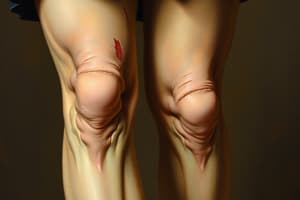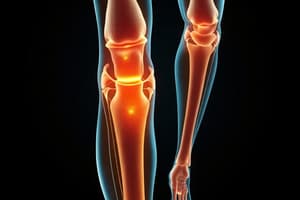Podcast
Questions and Answers
What is the primary cause of Genu Varum in infants?
What is the primary cause of Genu Varum in infants?
- Osteoarthritis
- Vitamin D deficiency
- Developmental and physiologic factors (correct)
- Congenital malformation
What surgical procedure is generally indicated for Genu Valgum that doesn't resolve by age 8?
What surgical procedure is generally indicated for Genu Valgum that doesn't resolve by age 8?
- Osteoporosis correction
- Supracondylar osteotomy of the femur (correct)
- Meniscectomy
- Subtrochanteric osteotomy
At what angle is the neck-shaft angle considered to be coxa vara?
At what angle is the neck-shaft angle considered to be coxa vara?
- More than 130°
- Between 110° and 125°
- Less than 90°
- Less than 110° (correct)
What condition is indicated by an angle above the normal carrying angle of 10-15 degrees in the elbow?
What condition is indicated by an angle above the normal carrying angle of 10-15 degrees in the elbow?
Which condition is associated with defective formation of osteoid?
Which condition is associated with defective formation of osteoid?
What primarily characterizes Osteogenesis Imperfecta?
What primarily characterizes Osteogenesis Imperfecta?
What is the cause of Coeliac Rickets?
What is the cause of Coeliac Rickets?
Which clinical feature is NOT typically associated with Rickets?
Which clinical feature is NOT typically associated with Rickets?
Which X-ray finding is indicative of Rickets?
Which X-ray finding is indicative of Rickets?
Which management strategy is NOT part of orthopedic treatment for Osteogenesis Imperfecta?
Which management strategy is NOT part of orthopedic treatment for Osteogenesis Imperfecta?
Flashcards are hidden until you start studying
Study Notes
Orthopaedic Deformities
- Deformities can be either congenital or acquired
- Most deformities may require surgery
Knee Deformities
- Genu Varum (Bowleg)
- In infants, the most common cause is developmental and physiological
- The deformity corrects itself with growth, usually by age 4
- In children (aged 1.5-2 years), Rickets is the most common cause
- Rickets is associated with systemic signs, symptoms, and laboratory findings
- Rickets treatment is directed towards correcting the cause, typically vitamin D deficiency
- Advanced cases of Rickets may require osteoclasis or osteotomy
- In adults, Osteoarthritis, mal-united fracture, ligamentous injury, and Paget's disease are the main causes
- Treatment for adult bowlegs is surgical correction of the deformity
- Genu Valgum (Knock Knees)
- Valgus knee up to age 4 is usually developmental or physiological
- Most cases self-correct by 6-8 years
- Progressive valgus knee after age 4 requires a supracondylar osteotomy of the femur
Hip Deformities
- Normal neck-shaft angle of the proximal femur is 160° at birth, decreasing to 125° in adulthood
- Coxa Vara: Angle less than 110°
- Coxa Valga: Angle more than 130°
- Both lead to gait disability and secondary spinal pain and deformity
- Treatment is by corrective subtrochanteric osteotomy
Elbow Deformities
- Normal carrying angle is 10-15 degrees of valgus, allowing for objects to be carried alongside the trunk while walking
- Cubitus Valgus: Angle above 15 degrees
- Cubitus Varus: Angle below 10 degrees
- These deformities are corrected surgically through a wedge osteotomy at the lower humerus
Bone Softening Diseases
- Bone Cells:
- Osteoblasts : bone forming cells
- Osteoclasts : bone resorbing cells
- Bone Matrix: Osteoid, formed of collagen with calcium salts deposited
- Causes of Bone Softening Diseases:
- Defective osteoid formation, e.g., osteogenesis imperfecta
- Defective mineralization of osteoid, e.g., rickets
- Increased bone resorption by osteoclasts, e.g., hyperparathyroidism
- Decreased bone formation by osteoblasts, e.g., osteoporosis
Osteogenesis Imperfecta
- Generalized mesenchymal disorder characterized by:
- Defective osteoid production leading to fragile bone and multiple fractures
- Defective collagen production resulting in joint hyperlaxity and blue sclera
- Types:
- Congenital: Still-born or born with multiple fractures
- Infantile: Manifestations early in infancy with multiple fractures
- Tarda: Manifestations develop in late childhood
- No specific treatment for the condition
- Orthopedic management:
- Preventing fractures and deformities with supportive devices
- Treating current fractures
- Correcting deformities through surgery
Rickets
- Disease of growing bone due to inadequate calcification of bone matrix
- Causes:
- Infantile Rickets: Deficient vitamin D intake and lack of sunlight exposure
- Coeliac Rickets: Deficient absorption of fat and vitamin D due to gluten intolerance
- Renal Rickets: Disturbed calcium-phosphorus metabolism due to renal dysfunction
- Clinical Picture:
- Bony deformities causing bow legs (genu varum) or knock knees (genu valgum)
- Characteristic signs of infantile rickets include:
- Boxy-bossy skull
- Rickety rosary
- Pigeon chest
- Harrison sulcus
- Broad metaphysis
- Marfan sign
- 10 Important clinical features in Rickets:
- Delayed closure of fontanelles
- Frontal bossing
- Dental hypoplasia
- Pectus carinatum
- Swelling in wrist and ankle joints
- Wide sutures
- Craniotabes
- Rachitic rosary
- Harrison's sulcus
- Bowing of legs
- X-Ray:
- Bone rarefaction (decreased density)
- Broadened and cupped metaphyses with brush border
- Healing shows a line of calcified bone replacing the frayed brush border
- Treatment:
- Infantile Rickets: Diet rich in calcium, phosphorus, and vitamin D, sunlight exposure, vitamin D and calcium administration.
- Renal Rickets: High doses of vitamin D (one alpha) and calcium
- Severe deformities may require osteotomy
Hyperparathyroidism
- Primary hyperparathyroidism: Increased parathyroid hormone secretion due to hyperplasia or tumour
- Causes increased bone resorption by osteoclasts, leading to:
- Hypercalcemia
- Recurrent renal calculi
- Bone resorption causes cystic changes, bone deformities, and pathological fractures
- Treatment: Surgical excision of parathyroid adenoma
Osteoporosis
- Bone mass loss: Reduced bone formation by osteoblasts due to aging and menopause
- Common sites affected:
- Vertebral column: Weakens vertebrae, causing collapse, back pain, kyphosis, and wedged or biconcave vertebrae on X-ray
- Proximal femur
- Proximal humerus
- Distal radius (prone to fracture)
- Diagnosis: Bone Densitometry (DEXA)
- Treatment:
- Diet: Calcium, vitamin D, and proteins
- Exercise: Daily exercise and sunlight exposure
- Medications:
- Calcium and vitamin D
- Calcitonin (increases osteoblastic activity)
- Bisphosphonates (inhibit osteoclastic activity)
- Hormonal Replacement Therapy (HRT) in some cases
Studying That Suits You
Use AI to generate personalized quizzes and flashcards to suit your learning preferences.





